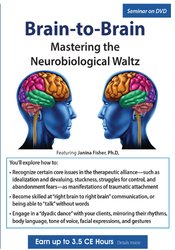Description
Clients raised by neglectful and frightening caregivers may as adults find themselves living with an unconscious somatic legacy of early traumatic attachment, yearning for closeness but unable to tolerate or sustain intimacy. Even their nervous systems rebel against physical proximity to others, or can’t tolerate being without proximity. As a result, their relationships—even with therapists—are tumultuous. The necessary strategy for working with these clients is coregulation, an approach that doesn’t depend on words but rather on a brain-to-brain neurobiological waltz that relies on the therapist’s attunement to implicit emotional and somatic communication. You’ll explore how to:
- Recognize certain core issues in the therapeutic alliance—such as idealization and devaluing, stuckness, struggles for control, and abandonment fears—as manifestations of traumatic attachment
- Become skilled at “right brain to right brain” communication, or being able to “talk” without words
- Engage in a “dyadic dance” with your clients, mirroring their rhythms, body language, tone of voice, facial expressions, and gestures
CPD
CPD
- PESI Australia, in collaboration with PESI in the USA, offers quality online continuing professional development events from the leaders in the field at a standard recognized by professional associations including psychology, social work, occupational therapy, alcohol and drug professionals, counselling and psychotherapy. On completion of the training, a Professional Development Certificate is issued after the individual has answered and submitted a quiz and course evaluation. This online program is worth 2.75 hours CPD for points calculation by your association.
Faculty
Janina Fisher, PhD, is a licensed clinical psychologist and former instructor at The Trauma Center, a research and treatment center founded by Bessel van der Kolk. Known as an expert on the treatment of trauma, Dr. Fisher has also been treating individuals, couples, and families since 1980.
She is the past president of the New England Society for the Treatment of Trauma and Dissociation, an EMDR International Association Credit Provider, Assistant Educational Director of the Sensorimotor Psychotherapy Institute, and a former Instructor, Harvard Medical School. Dr. Fisher lectures and teaches nationally and internationally on topics related to the integration of the neurobiological research and newer trauma treatment paradigms into traditional therapeutic modalities.
She is co-author with Pat Ogden of Sensorimotor Psychotherapy: Interventions for Attachment and Trauma (2015) and author of Healing the Fragmented Selves of Trauma Survivors: Overcoming Internal Self-Alienation (2017) and the forthcoming book, Working with the Neurobiological Legacy of Trauma (in press).
Speaker Disclosures:
Financial: Dr. Janina Fisher has an employment relationship with the Sensorimotor Psychotherapy Institute. She is a consultant for Khiron House Clinics and the Massachusetts Department of MH Restraint and Seclusion Initiative. Dr. Fisher receives royalties as a published author. She receives a speaking honorarium, recording royalties and book royalties from Psychotherapy Networker and PESI, Inc. Dr. Fisher has no relevant financial relationships with ineligible organizations.
Non-financial: Dr. Janina Fisher is on the advisory board for the Trauma Research Foundation. She is a patron of the Bowlby Center.
Outline
- Therapeutic relationship as dance between attachment systems
- Impact of early childhood experiences on attachment and affect regulation
- Arousal and self-regulation
- Secure v. insecure context
- Brain structures and systems related to self-regulation of affect
- Functions of sympathetic and parasympathetic nervous system
- Consequences of hypoarousal and hyperarousal
- Unconscious nature of early attachment experiences
- Body memory/somatic learning
- Approach v. avoidance
- Therapeutic relationship and managing sense of threat
- Styles of attachment
- Unconscious nature of body memory
- Nonverbal cues and therapeutic communication
- Successful regulation of arousal
- Optimal window of arousal
- Sources of therapist dysregulation
- Identifying somatic transference and countertransference
- Sensorimotor Psychotherapy
- Impact of internal dialog, labeling
- Mind/body integration
- Integrating mindfulness practices
- Co-regulation in interpersonal psychotherapy
- Effective methods of communication
- Connecting and integrating sensory perceptions
- Experimentation as technique
- Working brain to brain
- Role of mirror neurons
- Social engagement system
- Flowing with resistance
- Summary
Objectives
- Explore how to recognize certain core issues in the therapeutic alliance—such as idealization and devaluing, stuckness, struggles for control, and abandonment fears—as manifestations of traumatic attachment
- Explore how to become skilled at “right brain to right brain” communication, or being able to “talk” without words
- Explore how to engage in a “dyadic dance” with your clients, mirroring their rhythms, body language, tone of voice, facial expressions, and gestures
Target Audience
Addiction Counselors, Counselors, Marriage and Family Therapists, Nurses, Psychologists, Social Workers


